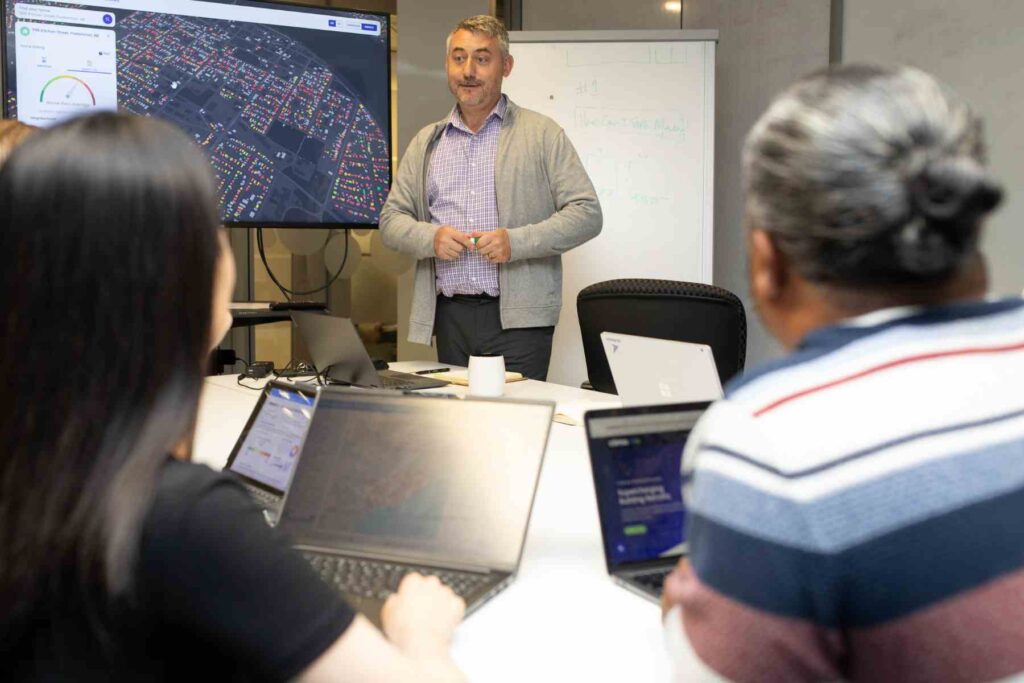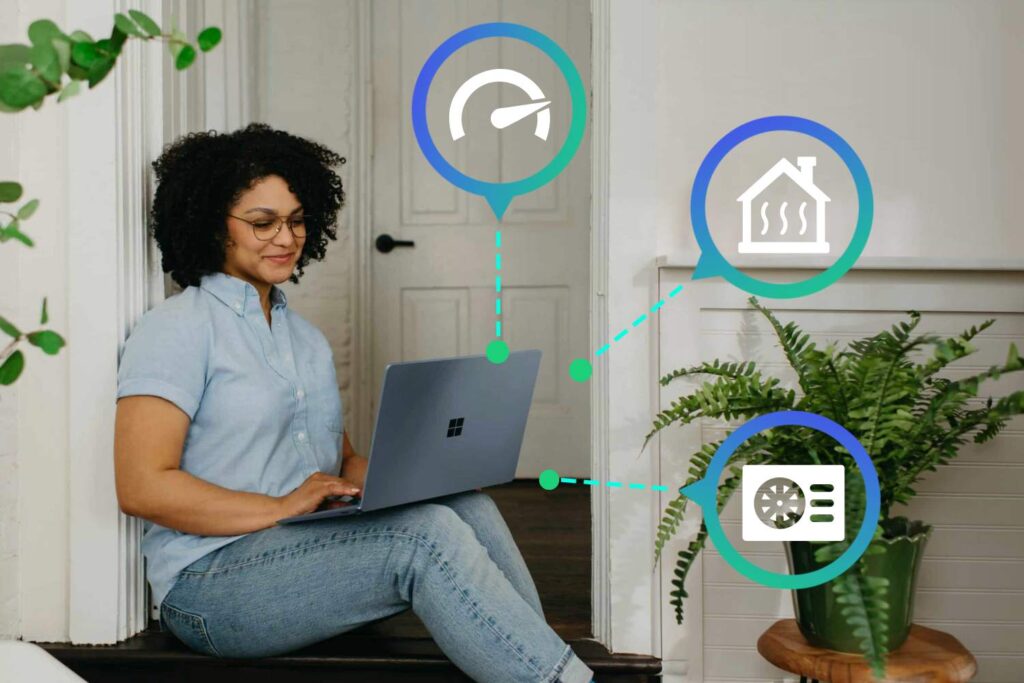Upgrading Your Home Shouldn’t Be So Complicated, Let’s Make it Easier to Save the Planet
To meet climate targets, millions of homeowners need to retrofit their homes to lower emissions. While most homeowners want a home that’s more comfortable, planet-friendly, and has lower operating costs, the resources available to support energy efficiency retrofits aren’t easy to access. How can we make the path to saving the planet more accessible for everyone?
If Planning a Vacation Were Like Upgrading a Home
Imagine planning a special family vacation. It will be expensive, so you want to talk to an expert.
You call your local travel agent, but to your surprise, they can only provide advice by seeing you in person. You take time off work to meet with them, go to the travel agent’s office, and spend hours telling them about your vacation plans. At the end of all this, they give you a “travel tips report,” and they mention that some seat sales are available, but they won’t provide specifics—you’ll have to figure that part out on your own. Afterward, you spend even more time calling around for hotels, rental cars, and tour companies, never really knowing if you’ve gotten the best deal, and all of the “seat sales” you heard about are mail-in rebates with a 20-week delivery time!

Sounds frustrating, right? Imagine having to juggle this uncertainty while you’re trying to relax on your well-deserved vacation. Would you want to deal with all that hassle?
Probably not. Most people wouldn’t.
Now, what does this scenario have to do with saving the planet?
The Complexity of Climate Action
Our nightmare vacation planning scenario mirrors the real challenges people face when making energy-efficiency improvements to their homes. Just as booking a trip becomes more stressful when the information is incomplete, or the savings are unclear, improving your home becomes much harder when the path to success is uncertain. For every home, there’s a net-zero pathway that gives you the best bang for your buck. It might be solar panels, insulation, energy-efficient appliances, heat pumps, or some combination of improvements. Any way you shake it, the process requires you to juggle estimates from different installers, learn complicated technical jargon, and navigate a maze of government incentives or tax rebates. Finding the best cost-benefit in all this is difficult, making it risky.
“…improving your home becomes much harder when the path to success is uncertain”
– Winston Morton
As soon as it’s “risky,” you’re less likely to take your first step toward improving your home’s energy efficiency. Going back to the travel agent analogy, would the risk factor make you question your willingness to embark on the trip of a lifetime? Risk and uncertainty of potential benefits are among the biggest reasons we avoid change.
Why People Avoid Energy-Efficient Choices
Humans are wired to avoid complexity and uncertainty, especially when it comes to big investments like retrofitting a home or changing daily habits. If we’re not sure what the result will be—whether in terms of cost savings, energy efficiency, or even comfort—it becomes easier to procrastinate or avoid taking action altogether. The issue is particularly evident when we look at the relatively low adoption rates of energy-efficient technologies despite their clear long-term benefits, such as lower operating costs.
A key factor here is that many people still view climate action as inconvenient and burdensome, just like planning that big vacation. The time, energy, and effort required to gather information, compare options, and determine whether the investment will pay off in the long run can feel too much of a hassle.

Simplifying the Climate Journey
Now, imagine a different scenario. What if the travel agent could provide you with everything you needed at the click of a button? You could get customized vacation packages, pricing details, and even the potential rebate estimate all in one place. That’s the kind of experience people want when making big decisions, and that’s the type of simplicity we need to create for climate action.
Most people are not experts when it comes to home energy upgrades. They would like an expert to help chart the optimal pathway that saves energy, upgrades comfort, and makes energy more affordable.
It’s well understood that two key barriers homeowners face to upgrading their homes are KNOWLEDGE and CAPITAL.
According to the Residential Retrofits for Energy Equity Playbook, the keys to making energy efficiency support more accessible are:
- Employ a “one-stop shop” approach for homeowners to access the necessary knowledge and capital to upgrade their homes
- Give homeowners a single point of contact to guide them through the retrofit process, from application to project completion
- Make it easy for homeowners to find and compare skilled contractors from their community to support the local workforce
- Provide a variety of funding options (government, utility, tax credits, etc.)
- Cover a large share of the total upfront costs of the scope of work
Most people want a simple, user-friendly solution that tells them exactly what they need to do, how much it will cost, and how much they will save—both in energy consumption and in dollar terms.
Making Climate Solutions Accessible
This is where new technology can play a pivotal role in changing how people approach climate action. Services that streamline the process of home energy assessments, like AI-powered energy audits or apps that offer clear estimates of costs and savings, can reach and educate very large numbers of people at once. Instead of calling multiple contractors, applying for rebates, and doing their own energy calculations, homeowners across the country can get tailored, immediate feedback on how to improve their property’s energy efficiency.
“…new technology can play a pivotal role in changing how people approach climate action”
– Winston Morton
For example, an AI-driven platform could analyze a home’s energy use by looking at factors such as square footage, geographic location, and current insulation levels. Within minutes, the system could provide homeowners with a list of recommended upgrades, estimated costs, and potential savings. It could even guide them through applying for government rebates, ensuring that they maximize the financial benefits of their investment.
Suddenly, climate action no longer feels like a burden—it becomes an easy, accessible choice.
How Simplicity Encourages Action
Simplifying energy efficiency is not just about making it easier for individuals; it’s about driving large-scale change. When more people can act without feeling overwhelmed, the transition to a low-carbon economy accelerates, helping meet global climate goals.
If millions of homeowners made energy upgrades, it would significantly reduce energy demand and greenhouse gas emissions. It would also boost the green energy sector, creating jobs and fostering innovation.
The key is to make climate-friendly choices simple. People act when the benefits are clear, and the effort is minimal. Personalized assessments, streamlined rebates, and cost-saving calculations help remove barriers to action.
“Simplifying energy efficiency is not just about making it easier for individuals; it’s about driving large-scale change.”
– Winston Morton

The Future of Climate Action
The good news is that this transformation has begun. New platforms and tools now help individuals and businesses understand their environmental impact and take action. From smart home energy systems to carbon calculators, technology is simplifying the path to sustainability.
But we can’t stop here. Large-scale climate action requires continued innovation to make sustainability easy and attractive for everyone. We must remove complexity and create a world where saving the planet is as simple as planning a vacation.
In the end, saving the planet shouldn’t feel like a burdensome task—it should feel like the obvious, easy choice. The easier we make it, the more people will join the cause, and the greater our impact will be.
Climative uses AI to generate unique low-carbon plans for homes in a market at a rate of one million per day. We work with public and private sector organizations who understand this data’s potential for accelerating net-zero retrofits to meet climate goals. Visit climative.ai to learn more about our offerings for financial institutions, efficiency programs, remote audits, and more.














